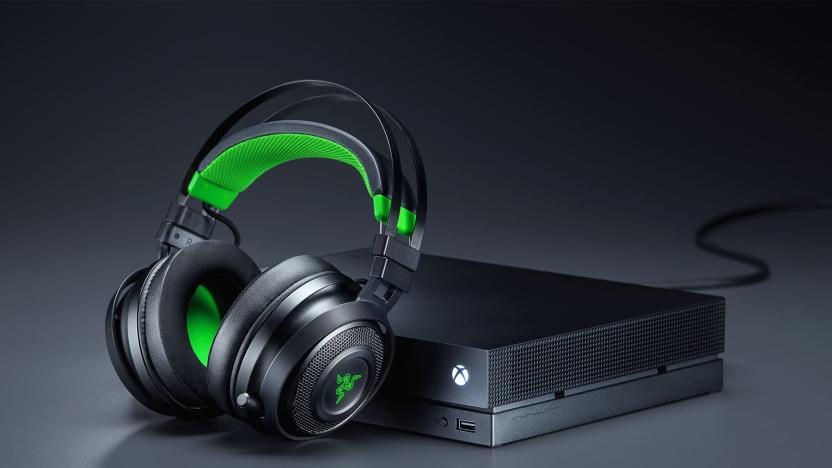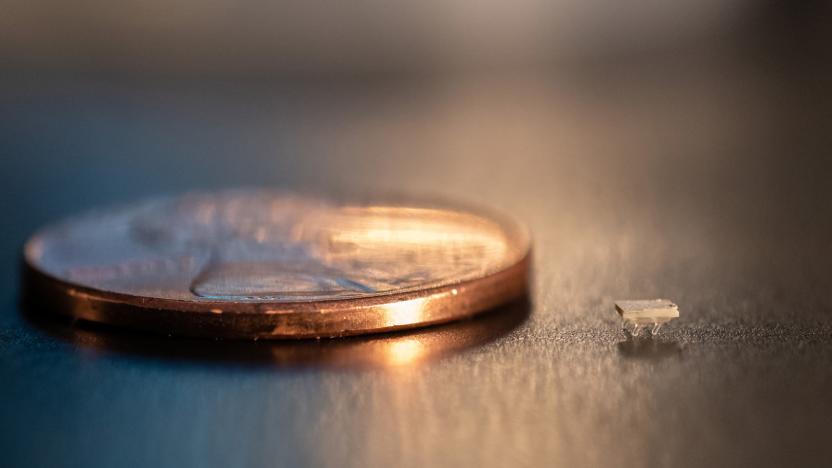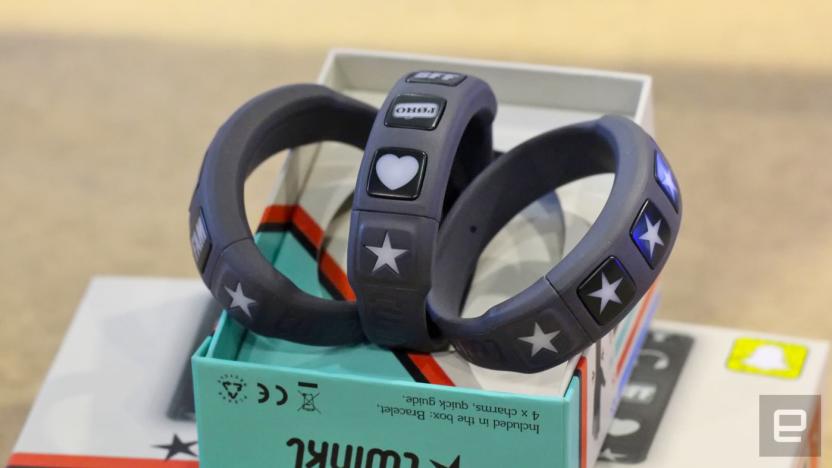vibration
Latest

Valve tests wireless rumble support for the DualSense in Steam
There’s good news if you’re trying to use Sony’s new controller to play PC games.

OhMiBod's Nex 3 is a smart vibrating couples ring
Perennial CES attendee OhMiBod is launching a Bluetooth-connected couples ring that promises a more enjoyable time with your partner. Unlike the previous Nex devices, the blueMotion Nex 3 is designed to be worn as an actual ring, increasing pleasure during couple's play. It does, however, share at least one signature feature with its predecessors: the ability to vibrate in tune with the music that you're playing on your smartphone.

Razer brings its vibrating Nari Ultimate headset to Xbox One
Last September, Razer unveiled a wireless headset called the Nari Ultimate that doubled as a rumble pack. That's right -- in addition to conventional drivers (which by their very nature vibrate), the headphones had haptic actuators in each cup. The only problem? They were designed specifically for PC players. The headphones technically worked with Xbox One but you had to rely on a traditional 3.5mm jack. Well, today that all changes with the Razer Nari Ultimate for Xbox One. As its name implies, this version brings the full head-rumbling experience to Microsoft's family of consoles. Like the original, these headphones offer HyperSense-branded haptics by Lofelt, a German company that also worked on the Basslet wearable and a rumble module for Teenage Engineering's OP-Z sequencer and synthesizer. The vibrations work with "any Xbox One game," Razer claims, to create "an immersive in-game experience." That means they'll emphasize subtle footsteps, heart-stopping explosions and other dramatic audio cues. Some will scoff at the idea -- we don't blame you, it's an understandable reaction -- but reviews for the original Nari Ultimate were positive. If you want to give the Xbox version a shot, it's launching today for $199.99/€219.99. The headphones will be competing with the impressive but haptic-free SteelSeries Arctis 9X, Razer's older Thresher headsets, and the plethora of wireless Turtle Beach headsets that dominate bricks-and-mortar stores.

Tiny vibration-powered robots could repair your body from the inside
There are many challenges to developing robots that could operate within your body, not the least of which is finding a power source -- you can't exactly strap a big battery on them. That might not be an issue thanks to Georgia Tech researchers. They've developed minuscule "bristle-bots" that move by tapping vibration from a variety of sources, whether it's ultrasound or a nearby speaker. The trick was to mate a tiny piezoelectric actuator to a 3D-printed polymer body whose bristle-like legs are angled to move in specific directions in a resonant response to vibrations.

Razer's 'Hypersense' vibration tech shakes your whole gaming rig
When Razer released its Nari gaming headset this past fall, it brought haptics, or vibration feedback, to a new realm: your head. I'm not sure anyone was asking for that, but if the idea of adding some haptic feedback to your favorite games sounds appealing in any way, Razer my soon have the product(s) for you.

Apple Watch rumor suggests 'solid state' buttons are coming
Now that the Apple Watch has built-in LTE, what could change in the next version? A rumor from Fast Company suggests that the Watch could follow Apple's "Force Touch" equipped laptops or iPhone 7 (and higher) models by making the button and digital crown "solid state" parts that don't actually move when clicked. While the crown is still said to rotate freely, a click would be simulated by vibrations from the Apple Watch's Taptic Engine. Like the laptops and phones, removing a moving part could make the device more reliable, easier to build, increase space for important things like extra battery, and more. The other part of the rumor is that these buttons could also host sensors capable of health tracking, and push the device toward a future where it doesn't have any buttons at all. But first, the moving parts have to go.

Tiny ‘hearing’ device is 100,000 times thinner than your eardrum
Finding long-range, low-powered sensors for wearable devices is the next scientific frontier. Researchers at Case Western Reserve University are working on atomically thin transducer "drumheads" that can send and receive signals at radio frequencies even greater than those we can hear with our natural ear. Better yet, the drumhead is 10,000,000,000,000 times smaller in volume and 100,000 times thinner than the human eardrum and can detect a much wider range of signal than other similar devices.

Twinkl is a friendship bracelet for the 21st century
Telling people that you're thinking about them is so much of a chore for energy-deficient millennials that something had to be done. That's the idea behind Twinkl's charm bracelet, a wearable that lets you send positive thoughts to your chums at the push of a single button. Each device comes with five slots that you can buy charms for, each one identifying a family member, close friend or your favorite content creator. When you want to let 'em know they're in your mind, simply hit their corresponding button and their wrist will buzz.

'Football Fan Shirt' uses haptics to help you feel the big match
If you're already a huge fan of football (aka soccer) and wish you could feel those sweet victories and bitter defeats, Wearable Experiments thinks it can help. Just in time for the Euro 2016 tournament, it's showing off an international version of its smartphone-connected Football Fan Shirt that sends haptic vibrations to your torso whenever there's a big play by a team you follow. You'll savor goals that much more, of course, but the clothing can also register everything from tackles to the dreaded red card.

Researchers hack phone vibration motor to act as a microphone
On the list of things that might be eavesdropping on your day-to-day conversations, the tiny motor that makes your phone buzz isn't necessarily the first one that comes to mind. But that is exactly what happens with the VibraPhone -- a proof-of-concept device created by two researchers from the University of Illinois at Urbana-Champaign to show that the motor in your smartphone or fitness tracker can be re-wired to act as a serviceable microphone.

Spiders are the key to ultra-sensitive wearable devices
Spiders might creep you out, but don't dismiss them too quickly -- they may well be the ticket to a new wave of wearable sensors. South Korean researchers have built a device that picks up miniscule vibrations by using the principle behind a spider's lyriform organs, which shake (and send nervous signals) in response to the rubbing motions of a nearby mate. The artificial system recreates the lyriform's slits using layers of platinum and soft polymer with electricity passing through. Even very small changes in the size of those slits will alter the electrical resistance, which makes it easy to measure faint vibrations.

Visual microphone can pick up speech from a bag of potato chips
You may want to be careful about the conversations you hold in the future; if you're near a window, someone might be listening in. A team of researchers from Adobe, Microsoft and MIT have developed a visual microphone algorithm that picks up audio by looking for microscopic vibrations in video footage. The technique exploits the rolling shutter effect in digital cameras (where the sensor reads pixels one row at a time) to detect sound-related movements that might otherwise be invisible; the only gear you need is a camera that can record at high frame rates. It's good enough to capture singing from a bag of potato chips, and musical tones from a potted plant.

MIT researchers develop chip that can harvest energy from multiple sources
We've seen a number of different devices that can harvest energy from various sources, but none quite like this new chip developed by a team of MIT researchers. It's able to harvest energy from three different sources simultaneously: light, heat and vibrations. The key to that is a sophisticated control system that's able to rapidly switch between the three sources at all times to prevent any of that energy from going to waste (and not draw too much power itself), with energy from the secondary sources stored in capacitors to be picked up later -- as opposed to existing systems that simply switch between sources based on what's most plentiful. As doctoral student Saurav Bandyopadhyay explains, efficiently managing those disparate sources could be a "big advantage since many of these sources are intermittent and unpredictable," and it could in turn lead to the chip being used in a range of different applications where batteries or existing energy harvesting methods just aren't enough: everything from environmental sensors in remote locations to biomedical devices.

'Free form' lens over mobile display could improve audio and haptics, says Motorola patent filing
It's hard to tell exactly what Motorola is thinking of here, but it probably isn't a billowing sheet of fabric stretched loosely over the face of a smartphone -- even if that's what it looks like. Instead, this appears to be a patent application for a "free floating display lens" that helps the panel of a mobile device to be used as a Beo-style acoustic speaker. The idea is that you can get louder and less resonant sound without having to dedicate more precious real estate to a larger traditional speaker unit. The application also talks about generating haptic feedback on the lens, using the same underlying piezoelectric structures that would power the audio. Creating vibrations this way could require "eight times" less voltage than current methods while also delivering a higher-amplitude sensation. Merge that with KDDI's weird vibrational speaker technology and the results could be deafening.

AT&T Labs, Carnegie Mellon research haptic-feedback steering wheel for turn-by-turn directions
A force-feedback steering wheel. It's quite literally the stuff of racing games, and AT&T labs, along with Carnegie Mellon, is researching the possibly of throwing similar tech into your real-world whip. MIT's Technology Review recently highlighted the project, which uses 20 vibrating actuators shoved inside of a steering wheel to create a variety of patterns -- a counter-clockwise sequence could indicate a left turn, for example. As you might have guessed, one of the goals is to keep drivers less distracted by the likes of visual turn-by-turn GPS navigators and more focused on the road. While it's currently being tested with driving simulators, the results are positive so far, if a bit modest. When supplemented with typical audio / visual navigation, folks near the age of 25 kept their eyes planted on the asphalt for 3.1 percent more time than without it. Notably, the improvement wasn't found with those over 65 in the aforementioned instance, however, supplemented with just the audio, the vibrating wheel had them focusing on the road by an increase of four percent.According to Technology Review, this isn't the first time haptic feedback has been tested as a driving aid, although past tests have, notably, resulted in "fewer turn errors" by those behind the wheel. Best of all, the tech is capable of sending more than just navigation cues -- it could certainly be useful in a Telsa. So when can you expect to find a force-feedback steering wheel in your ride? Technology Review cites Kevin Li, an AT&T Labs researcher on the project, who says the main hurdle is making something that people will just "get," and that it's still "years" away from becoming a possibility. While there's no photos of the setup just yet, a full report on the research will get released in June. Hey, there's always Forza and Gran Turismo, at least for now -- right?

Crapgadget CES, round six: 4D Vibestar vibrating lumbar speaker system
Combining two of our favorite things, massages and LOUD noises. Feel the sound... in your lower-back.

Researchers convert soundwaves into electromagnetic energy, silence no longer golden
Researchers in Japan and Germany have converted energy from soundwaves into electromagnetic energy, trapping a magnetic "spin current" between metal layers. In the experiment, when sound waves are directed at an interface between the thin metal layer and magnetic material, electrical signals are generated at a pair of electrodes attached above. When the soundwaves reach the magnetic material, this creates a spin current that gets picked up by three layers of metal. This is where the exercise class-sounding reverse spin Hall effect kicks in, transforming it into an electrical voltage. Not to be confused with Orange's Sound Charge T-Shirt, scientists believe that it should be possible to generate that mystical electromagnetic energy from any material in the future. At the moment, the project is looking into materials that are able to eke out more voltage from the process -- perhaps a few years later screaming at our phones will give their batteries a boost? Watch the video after the break for more technical details and close-ups of the equipment.

Vibrating glove prototype lets you hold on to that feeling
The secret to increasing tactile sensations? Good vibes, man. Georgia Tech scientists have unveiled a prototype glove that helps improve the feeling of its wearer by adding vibration. The gloves add physical "white noise," improving the sense of touch in the fingertips of the user. The whole thing is still in the early stages of testing, but the glove's inventors believe that it might some day find real world applications amongst people in occupations that require a good deal of manual dexterity and those with medical conditions that have dulled the feeling in their hands.

Kinect-driven tactile bodysuit makes you tingle in eight different places
We know the US Army has already experimented with vibrating clothing, and soon it could be our turn. The trendy figure-hugger above is rigged with haptic actuators across the arms and torso, which respond when the wearer's body 'touches' virtual objects created via Microsoft's Kinect platform. The outfit's designers at the University of Aachen spent just a few hundred dollars on components, aside from the cost of the Kinect, so this might well have commercial potential. Click the source link if you're really keen to see a concept video -- although it doesn't consist of much beyond a German dude doing the Hey Macarena in his socks. [Thanks, Jarod]

Orange Sound Charge T-shirt will juice up your phone while you listen to the bass go boom
Orange UK has a long-running tradition of coming up with quirky ways to recharge your phone while enjoying the Glastonbury Festival every year, and 2011 is proving no different. This time around, it's a T-shirt that generates an electric charge from the sound around it -- rendering it ideal for front-row crowd-surfing types -- though the provided tech details go no further than to tell us that piezoelectrics and the absorption of vibration are involved. We find ourselves overcome by the suspicion that you'll never be able to get much meaningful utility out of this rather unstylish garment, but then it does give you a plausible excuse for pushing your way nearer to the stage, and if anyone objects, you can consider it a great conversation starter. So whatever happens, you win, fashion loses.










